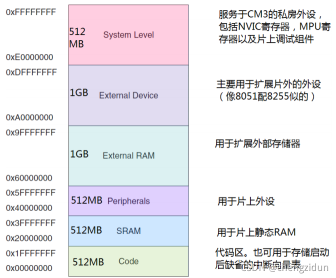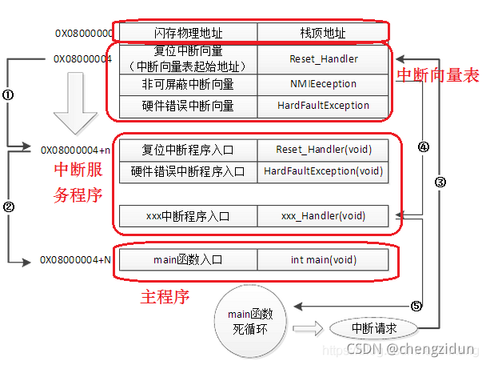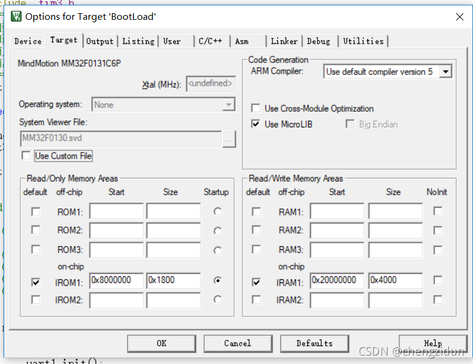RS485接口的IAP固件升级工具
前言
当我们采用MCU设计的电子产品在出售后、安装在野外、固件存在BUG时或客户需求有变动, 都需要对固件进行维护和升级。由于距离远且需频繁调试测试, 不可能每次都安装人手去现场升级固件, 势必会造成巨大的成本开销, 这是非常不利于企业发展的。因此, 需要对产品可进行远程升级固件, 而远程升级固件就要使用到IAP技术。
一、概述
??在介绍IAP技术前, 先了解下ISP技术。ISP(In-System Programming)在系统可编程,指电路板上的空白器件可以编程写入最终用户代码, 而不需要从电路板上取下器件,已经编程的器件也可以用ISP方式擦除或再编程。简单而言, ISP就是厂家在MCU芯片内植入了一段引导码, 可通过外设接口直接烧录程序进芯片,如串口。 ??IAP(In-Application-Programming)在程序中编程, 是一种对通过微控制器的对外接口如:USART,IIC,CAN,USB, 以太网接口甚至是无线射频通道等对正在运行程序的微控制器进行内部程序的更新的技术。不同于ISP通过设置MCU内部的BootLoader程序引导烧写或者是ICP通过SWD、JTAG在线仿真烧写。简单而言, IAP编程就是可以在程序运行时进行编程烧录的一种技术。本文以CM3内核MCU及RS485(即USART)接口作为IAP技术的应用。?
二、IAP技术原理
??IAP技术的核心是一段预先烧写在MCU内部的一个程序, 这个程序一般叫做bootloader。这段程序主要负责与外部的上位机软件进行握手同步,然后将通过外设通信接口将来自于上位机软件的程序数据接收后写入单片机内部指定的闪存区域,然后再跳转执行新写入的程序,最终就达到了程序更新的目的。 ??那IAP程序是如何实现的呢?这就要首先了解MCU内部闪存组织架构和其启动过程, STM32做为ARM-CM3的经典产品, 就以它做为参考来描述其中原理。下面是CM3储存器映射图, 给出各部件间的地址分配。
?
??可知RAM是从0x20000000处开始, 各厂家未必会一致, STM32的ROM地址是以0x8000000处开始。STM32内置Flash的分配情况大致如下图:
?
??下图是单个程序的启动过程, STM32有一个向量表, 从0x8000000+4处开始, 0x8000000处是栈顶地址。上电复位后从0x8000000+4处获取到复位中断向量地址, 然后跳转到复位中断程序入口标号1所示), 执行结束后跳转main函数。在执行main函数的过程中发生中断,则STM32强制将PC指针指回中断向量表处(标号3所示),从中断向量表中找到相应的中断函数入口地址,跳转到相应的中断服务函数,执行完中断服务函数后再返回到main函数中来。
?
??当使用IAP技术时, FLASH分配情况就会不一样, 如下图:
?
??使用了IAP技术的启动流程图如下图:
?
??关于新中断向量表的设置, 可以用void NVIC_SetVectorTable函数设置它在FLASH中的偏移量, 或者把它映射到RAM中。?
三、IAP编程实现
??根据上面的原理只要编写boootloader和APP(用户实际运行的程序)程序, 再编写上位机, 定义自定义协议交互即可实现IAP技术的应用, 就可远程升级固件。?
1.bootloader程序


?
#define ApplicationAddress 0x08001C00 //APP Address
#define ApplicationRemainingSize 57 //应用程序剩余flash大小 ( K byte)
uint16_t DFU_state;
typedef void (*pFunction)(void);
pFunction Jump_To_Application;
uint32_t JumpAddress;
uint16_t modbus_slave_address = 0;
int main(void)
{
DELAY_Init();
uart1_init();
RS485_RECV_EN();
DFU_state = DFU_read_state();
modbus_slave_address = modbus_slave_read_address();
if(modbus_slave_address == 0xFFFF)
{
modbus_slave_address = 1;
Setting_modbus_slave_address();
}
if (DFU_state == 0xaaaa)
{
__disable_irq();
if (((*(__IO uint32_t *)ApplicationAddress) & 0x2FFE0000) == 0x20000000)
{
// Jump to user application
JumpAddress = *(__IO uint32_t *)(ApplicationAddress + 4);
Jump_To_Application = (pFunction)JumpAddress;
// Initialize user application's Stack Pointer
__set_MSP(*(__IO uint32_t *)ApplicationAddress);
//Jump to APP
Jump_To_Application();
}
}
Tim3_UPCount_test(72 - 1, 100 - 1); // 100us定时 用于做UART空闲中断
while (1)
{
DELAY_Ms(10);
APP_Update();
}
}
?
2.APP程序

#define ApplicationAddress 0x08001C00 //APP addrress
#define VECTOR_SIZE 0xC0 //48*4=192 = 0xC0 中断向量表cope的大小
int main(void)
{
memcpy((void*)0x20000000, (void*)ApplicationAddress, VECTOR_SIZE); //把中断向量表映射到RAM里面跑
RCC_APB2PeriphClockCmd(RCC_APB2Periph_SYSCFG,ENABLE);
SYSCFG_MemoryRemapConfig(SYSCFG_MemoryRemap_SRAM);
__enable_irq();
while(1)
{
//user code
}
}

?
四、上位机的编写
??需要把APP程序生成的bin文件烧录进MCU, 则通过上位机的串口与MCU的串口的连接, 再把bin文件数据根据与bootloader程序定义的协议传送给MCU, bootloader实现对MCU内部的FLASH擦写, 所以上位机主要的工作就是实现bin文件数据的传送。该上位机是在windows平台下实现, 采用微软的VS2017的IDE和C#语言开发。
using System;
using System.Collections.Generic;
using System.Linq;
using System.Text;
using System.Threading.Tasks;
using System.IO.Ports;
using System.Threading;
using xUtilities;
using System.IO;
namespace IAP_Console
{
class BootloaderProtocol
{
private int retries;
private int writetimeout;
private int readtimeout;
private SerialPort _serialPort;
private static byte[] rbuffer = new byte[1024];
private static int receive_size;
private string bootversion;
private ushort appprogramsize; //KB
private int update_state; //0--没有更新,1--正在更新,2--停止更新,3--更新失败,4--更新完成
private const uint APP_BASE_ADDRESS = 0x08001C00; //APP基地址,以此地址进行更新程序
private const int APP_WRITE_DATA_MAXSIZE_ONCE = 1024; //单次发送允许最大字节
private const int APP_WRITE_DATA_SIZE_ONCE = APP_WRITE_DATA_MAXSIZE_ONCE; //单次发送字节, 不得超出允许最大字节
public const int APP_FLASH_TOTAL_SIZE = 57; //APP区的总共大小KB
public const int UPDATE_STATE_NO = 0;
public const int UPDATE_STATE_IN = 1;
public const int UPDATE_STATE_STOP = 2;
public const int UPDATE_STATE_FAIL = 3;
public const int UPDATE_STATE_COMPLETE = 4;
public int Retries
{
set { if (value == 0) retries = 1; retries = value; }
get { return retries; }
}
public int WriteTimeout
{
set { writetimeout = value; }
get { return writetimeout; }
}
public int ReadTimeout
{
set { readtimeout = value; }
get { return readtimeout; }
}
public string BootVersion
{
get { return bootversion; }
}
public int UpdateState
{
set { update_state = value; }
get { return update_state; }
}
public BootloaderProtocol(SerialPort serialport)
{
Retries = retries = 1;
WriteTimeout = writetimeout = 100;
ReadTimeout = readtimeout = 100;
bootversion = "";
appprogramsize = 0;
update_state = UPDATE_STATE_NO;
_serialPort = serialport;
_serialPort.WriteBufferSize = 4096;
_serialPort.ReadBufferSize = 4096;
_serialPort.ReceivedBytesThreshold = 1;
_serialPort.WriteTimeout = WriteTimeout;
_serialPort.ReadTimeout = ReadTimeout;
receive_size = 0;
_serialPort.DataReceived += new SerialDataReceivedEventHandler(SerialPort_DataReceivedEventHandler);
}
private void Send_data(byte[] buffer, int size)
{
try
{
_serialPort.WriteTimeout = WriteTimeout;
receive_size = 0;
_serialPort.Write(buffer, 0, size);
}
catch (TimeoutException)
{
throw new TimeoutException("send timeout");
}
catch
{
throw;
}
}
private byte[] Receive_data()
{
int timeoutcnt = 0;
while (receive_size > 0 || timeoutcnt < ReadTimeout)
{
if (receive_size > 0)
{
byte[] data = new byte[receive_size];
for (int i = 0; i < receive_size; i++)
{
data[i] = rbuffer[i];
}
receive_size = 0;
return data;
}
Thread.Sleep(10);
timeoutcnt += 10;
if (timeoutcnt > ReadTimeout)
{
receive_size = 0;
throw new TimeoutException("receive timeout");
}
}
return null;
}
private ushort Check_sum(byte[] data, ushort size)
{
int sum = 0;
ushort i = 0;
while (size > 0)
{
sum = sum + data[i];
i++;
size--;
}
while ((sum >> 16) > 0) //当和的高16位不为0,把高16位作为校验和的一部分求和,
sum = (sum & 0xffff) + (sum >> 16);
return (ushort)~sum;
}
private bool Check_data(byte[] data, ushort size)
{
bool flag_check = false;
ushort tmp_checksum = 0;
byte temp1, temp2;
tmp_checksum = Check_sum(data, (ushort)(data[1] - 2));
temp1 = (byte)(tmp_checksum & 0x00FF);
temp2 = (byte)((tmp_checksum >> 8) & 0x00FF);
if ((temp2 != data[data[1] - 2]) || (temp1 != data[data[1] - 1]))
{
flag_check = true;
}
return flag_check;
}
//查看BOOT版本:01 00 09 52 45 56 45 fe c3
public string Get_boot_version(byte mod_address)
{
byte[] cmd = new byte[] { 0x01, 0x00, 0x09, 0x52, 0x45, 0x56, 0x45, 0xFE, 0xC3 };
int retries_cnt = 0;
bootversion = "";
while (retries_cnt < Retries)
{
try
{
cmd[0] = mod_address;
ushort checksum = Check_sum(cmd, (ushort)(cmd.Length - 2));
cmd[cmd.Length - 2] = (byte)((checksum >> 8) & 0x00FF);
cmd[cmd.Length - 1] = (byte)(checksum & 0x00FF);
Send_data(cmd, cmd.Length);
byte[] data = Receive_data();
if (data != null)
{
if ((data.Length == cmd[2]) && (data[0] == cmd[0]) && (data[1] == (cmd[1]| 0xC0)) && (data[2] == cmd[2]))
{
byte[] version = new byte[4];
for (int i = 0; i < 4; i++)
{
version[i] = data[i + 3];
}
bootversion = "Ver" + ((version[0] >> 4) & 0x0F).ToString() + (version[0] & 0x0F).ToString() + "." +
((version[1] >> 4) & 0x0F).ToString() + (version[1] & 0x0F).ToString();
appprogramsize = version[2];
return bootversion;
}
}
retries_cnt++;
if (retries_cnt >= Retries)
throw new Exception("retry the overflow");
}
catch (TimeoutException)
{
if (retries_cnt >= Retries)
throw new TimeoutException("request timeout");
}
catch
{
if (retries_cnt >= Retries)
throw new Exception("retry the overflow");
}
}
return bootversion;
}
//擦除BOOT标记并且重启(0xffff):01 20 0E 42 4F 4F 54 52 45 53 45 54 FD 19
public Boolean Erase_boot_flag_and_reset(byte mod_address)
{
byte[] cmd = new byte[] { 0x01, 0x20, 0x0E, 0x42, 0x4F, 0x4F, 0x54, 0x52, 0x45, 0x53, 0x45, 0x54, 0xFD, 0x19 };
int retries_cnt = 0;
while (retries_cnt < Retries)
{
try
{
cmd[0] = mod_address;
ushort checksum = Check_sum(cmd, (ushort)(cmd.Length - 2));
cmd[cmd.Length - 2] = (byte)((checksum >> 8) & 0x00FF);
cmd[cmd.Length - 1] = (byte)(checksum & 0x00FF);
Send_data(cmd, cmd.Length);
byte[] data = Receive_data();
if (data != null)
{
if ((data.Length == cmd[2]) && (data[0] == cmd[0]) && (data[1] == (cmd[1] | 0xC0)) && (data[2] == cmd[2]))
{
return true;
}
}
retries_cnt++;
if (retries_cnt >= Retries)
throw new Exception("retry the overflow");
}
catch (TimeoutException)
{
if (retries_cnt >= Retries)
throw new TimeoutException("request timeout");
}
catch
{
if (retries_cnt >= Retries)
throw new Exception("retry the overflow");
}
}
return false;
}
//擦除APP:01 21 0C 05 44 45 4C 41 50 50 FE 16
public Boolean Erase_app_and_boot_flag(byte mod_address, ushort erase_kb_size)
{
if((erase_kb_size == 0) || (erase_kb_size > appprogramsize)) throw new Exception("illegal parameters");
byte[] cmd = new byte[] { 0x01, 0x21, 0x0C, 0x05, 0x44, 0x45, 0x4C, 0x41, 0x50, 0x50, 0xFE, 0x16 };
int retries_cnt = 0;
while (retries_cnt < Retries)
{
try
{
cmd[0] = mod_address;
cmd[3] = (byte)erase_kb_size;
ushort checksum = Check_sum(cmd, (ushort)(cmd.Length - 2));
cmd[cmd.Length - 2] = (byte)((checksum >> 8) & 0x00FF);
cmd[cmd.Length - 1] = (byte)(checksum & 0x00FF);
Send_data(cmd, cmd.Length);
byte[] data = Receive_data();
if (data != null)
{
if ((data.Length == cmd[2]) && (data[0] == cmd[0]) && (data[1] == (cmd[1] | 0xC0)) && (data[2] == cmd[2]))
{
return true;
}
}
retries_cnt++;
if (retries_cnt >= Retries)
throw new Exception("retry the overflow");
}
catch (TimeoutException)
{
if (retries_cnt >= Retries)
throw new TimeoutException("request timeout");
}
catch
{
if (retries_cnt >= Retries)
throw new Exception("retry the overflow");
}
}
return false;
}
//修改BOOT标记(AAAA重启)01 22 0B 52 45 42 4F 4F 54 FE 06
public Boolean Set_boot_flag_and_reset(byte mod_address)
{
byte[] cmd = new byte[] { 0x01, 0x22, 0x0B, 0x52, 0x45, 0x42, 0x4F, 0x4F, 0x54, 0xFE, 0x06 };
int retries_cnt = 0;
while (retries_cnt < Retries)
{
try
{
cmd[0] = mod_address;
ushort checksum = Check_sum(cmd, (ushort)(cmd.Length - 2));
cmd[cmd.Length - 2] = (byte)((checksum >> 8) & 0x00FF);
cmd[cmd.Length - 1] = (byte)(checksum & 0x00FF);
Send_data(cmd, cmd.Length);
byte[] data = Receive_data();
if (data != null)
{
if ((data.Length == cmd[2]) && (data[0] == cmd[0]) && (data[1] == (cmd[1] | 0xC0)) && (data[2] == cmd[2]))
{
return true;
}
}
retries_cnt++;
if (retries_cnt >= Retries)
throw new Exception("retry the overflow");
}
catch (TimeoutException)
{
if (retries_cnt >= Retries)
throw new TimeoutException("request timeout");
}
catch
{
if (retries_cnt >= Retries)
throw new Exception("retry the overflow");
}
}
return false;
}
//写数据到APP的扇区 01 23 48 (00 1C 00 08) (xxxx xxxx) (SUM SUM)
public Boolean Write_app_data(byte mod_address, byte[] wdata, uint address, ushort size)
{
if ((size == 0) || (size > APP_WRITE_DATA_MAXSIZE_ONCE) || ((size % 2) != 0)) throw new Exception("illegal parameters");
byte[] cmd = new byte[size + 10];
int retries_cnt = 0;
cmd[1] = 0x23;
cmd[2] = (byte)((size + 10) & 0x00FF);
cmd[3] = (byte)(((size + 10) >> 8) & 0x00FF);
cmd[4] = (byte)(address & 0x000000FF);
cmd[5] = (byte)((address >> 8) & 0x000000FF);
cmd[6] = (byte)((address >> 16) & 0x000000FF);
cmd[7] = (byte)((address >> 24) & 0x000000FF);
for (int i = 0; i < size; i++)
{
cmd[8 + i] = wdata[i];
}
while (retries_cnt < Retries)
{
try
{
cmd[0] = mod_address;
ushort checksum = Check_sum(cmd, (ushort)(cmd.Length - 2));
cmd[cmd.Length - 2] = (byte)((checksum >> 8) & 0x00FF);
cmd[cmd.Length - 1] = (byte)(checksum & 0x00FF);
Send_data(cmd, cmd.Length);
byte[] data = Receive_data();
if (data != null)
{
if ((data.Length == 10) && (data[0] == cmd[0]) && (data[1] == (cmd[1] | 0xC0)) && (data[2] == 10))
{
return true;
}
}
retries_cnt++;
if (retries_cnt >= Retries)
throw new Exception("retry the overflow");
}
catch (TimeoutException)
{
if (retries_cnt >= Retries)
throw new TimeoutException("request timeout");
}
catch
{
if (retries_cnt >= Retries)
throw new Exception("retry the overflow");
}
}
return false;
}
//修改BOOT标记(AAAA不重启)01 25 0B 42 4F 4F 54 53 45 FE 02
public Boolean Set_boot_flag(byte mod_address)
{
byte[] cmd = new byte[] { 0x01, 0x25, 0x0B, 0x42, 0x4F, 0x4F, 0x54, 0x53, 0x45, 0xFE, 0x02 };
int retries_cnt = 0;
while (retries_cnt < Retries)
{
try
{
cmd[0] = mod_address;
ushort checksum = Check_sum(cmd, (ushort)(cmd.Length - 2));
cmd[cmd.Length - 2] = (byte)((checksum >> 8) & 0x00FF);
cmd[cmd.Length - 1] = (byte)(checksum & 0x00FF);
Send_data(cmd, cmd.Length);
byte[] data = Receive_data();
if (data != null)
{
if ((data.Length == cmd[2]) && (data[0] == cmd[0]) && (data[1] == (cmd[1] | 0xC0)) && (data[2] == cmd[2]))
{
return true;
}
}
retries_cnt++;
if (retries_cnt >= Retries)
throw new Exception("retry the overflow");
}
catch (TimeoutException)
{
if (retries_cnt >= Retries)
throw new TimeoutException("request timeout");
}
catch
{
if (retries_cnt >= Retries)
throw new Exception("retry the overflow");
}
}
return false;
}
//bootloader初始化
public Boolean Bootloader_init(byte mod_address)
{
//擦除标志复位后切换到boot模式(因为程序平时运行在APP模式下)
UpdateState = UPDATE_STATE_NO;
//获取boot版本
try
{
if (Erase_boot_flag_and_reset(mod_address) == false)
{
throw new Exception("Erase_boot_flag_and_reset fail");
}
Thread.Sleep(500); //软复位MCU后等待它切换到BOOT程序
if (Get_boot_version(mod_address).Equals("") == true)
{
throw new Exception("Get_boot_version fail");
}
return true;
}
catch (TimeoutException ex)
{
UpdateState = UPDATE_STATE_FAIL;
throw new TimeoutException("bootloader int timeout");
}
catch (Exception ex)
{
UpdateState = UPDATE_STATE_FAIL;
throw new Exception("bootloader int fail");
}
}
//bootloader更新APP文件
public Boolean Bootloader_app_file_update(byte mod_address, FileStream fs)
{
try
{
if (fs.Length == 0)
{
fs.Close();
throw new Exception("The file is empty");
}
ushort program_size_kb = (ushort)(fs.Length / 1024);
if ((fs.Length % 1024) != 0) program_size_kb++;
UpdateState = UPDATE_STATE_IN;
if (Erase_app_and_boot_flag(mod_address, program_size_kb) == false)
{
fs.Close();
throw new Exception("Erase_app_and_boot_flag fail");
}
Thread.Sleep(10);
int package_size = BootloaderProtocol.APP_WRITE_DATA_SIZE_ONCE;
int package_total = (ushort)(fs.Length / package_size);
if ((fs.Length % package_size) != 0) package_total++;
uint address = BootloaderProtocol.APP_BASE_ADDRESS;
byte[] data = new byte[package_size];
SendMessage_UpdataProgressBar(package_total, 0);
Thread.Sleep(10);
for (int i = 0; i < package_total; i++)
{
package_size = fs.Read(data, 0, (int)(package_size));
if (Write_app_data(mod_address, data, address, (ushort)package_size) == false)
{
fs.Close();
throw new Exception("Failed to write the app data");
}
address = (uint)(address + package_size);
if (UpdateState == UPDATE_STATE_STOP)
{
fs.Close();
SendMessage_UpdataProgressBar(package_total, 0);
throw new Exception("Stop updating the firmware");
}
SendMessage_UpdataProgressBar(package_total, i);
}
fs.Close();
SendMessage_UpdataProgressBar(package_total, package_total);
Thread.Sleep(20);
if (Set_boot_flag_and_reset(mod_address) == false)
{
throw new Exception("Failed to Set_boot_flag_and_reset");
}
UpdateState = UPDATE_STATE_COMPLETE;
}
catch (TimeoutException ex)
{
fs.Close();
UpdateState = UPDATE_STATE_FAIL;
throw new TimeoutException(ex.Message);
}
catch (Exception ex)
{
fs.Close();
UpdateState = UPDATE_STATE_FAIL;
throw new Exception("Failed to update the file");
}
return true;
}
private void SendMessage_UpdataProgressBar(int total, int current)
{
xUtilities.Message msg = new xUtilities.Message();
msg.what = Appconstant.MSG_UPDATE_PROGRESS;
msg.obj = (object)new int[] { total, current };
MainForm.g_handler.SendMessage(msg);
}
private void SerialPort_DataReceivedEventHandler(object sender, SerialDataReceivedEventArgs e)
{
try
{
if (_serialPort.IsOpen)
{
try
{
if (_serialPort.BytesToRead == 0)
{
return;
}
int byteNumber = 0;
//延时等待数据接收完毕。
while ((byteNumber < _serialPort.BytesToRead) && (_serialPort.BytesToRead < 4096))
{
byteNumber = _serialPort.BytesToRead;
Thread.Sleep(20);
}
_serialPort.Read(rbuffer, 0, byteNumber);
_serialPort.DiscardInBuffer();
receive_size = byteNumber;
}
catch (Exception ex)
{
}
}
else
{
TimeSpan waitTime = new TimeSpan(0, 0, 0, 0, 50);
Thread.Sleep(waitTime);
}
Thread.Sleep(200);
}
catch (Exception ex)
{
}
}
}
}
?
五、总结
??可见, IAP技术的应用很方便解决了远程固件升级问题, 有效节省的不必要的人力成本。当然我们不会局限于只用串口升级, 在万物互联的时代, 电子产品连网成了必要的功能, 采用网络升级更加发挥IAP技术的应用, 真可谓是把利剑。该文章IAP技术原理等部份内容摘录网友的, 如有侵权请告知。?
免责申明: 作者难免技术水平有限,如有错误拒不承认,本文技术资料只适于学习和参考,不可商用,若要商用,不必告知我,跟我没一毛关系。